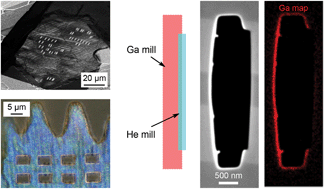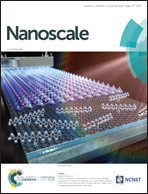Gallium, neon and helium focused ion beam milling of thin films demonstrated for polymeric materials: study of implantation artifacts†
Abstract
Focused ion beam milling of ∼200 nm polymer thin films is investigated using a multibeam ion microscope equipped with a gallium liquid metal ion source and a helium/neon gas field-ionization source. The quality of gallium, neon, and helium ion milled edges in terms of ion implantation artifacts is analyzed using a combination of helium ion microscopy, transmission electron microscopy and light microscopy. Results for a synthetic polymer thin film, in the form of cryo-ultramicrotomed sections from a co-extruded polymer multilayer, and a biological polymer thin film, in the form of the base layer of a butterfly wing scale, are presented. While gallium and neon ion milling result in the implantation of ions up to tens of nanometers from the milled edge and local thinning near the edge, helium ion milling produces much sharper edges with dramatically reduced implantation. These effects can be understood in terms of the minimal lateral scatter and larger stopping distance of helium compared with the heavier ions, whereby due to the thin film geometry, most of the incident helium ions will pass straight through the material. The basic result demonstrated here for polymer thin films is also expected for thin films of hard materials such as metals and ceramics.



 Please wait while we load your content...
Please wait while we load your content...
